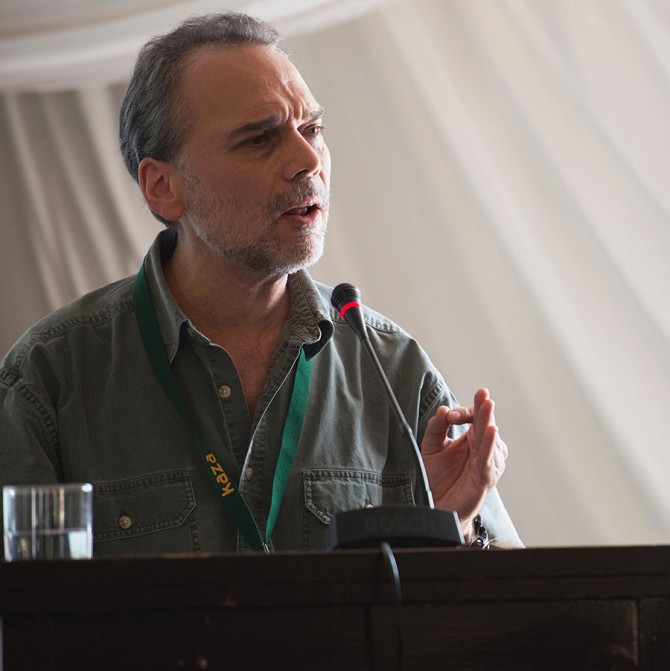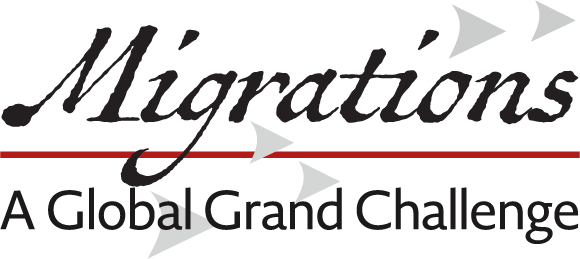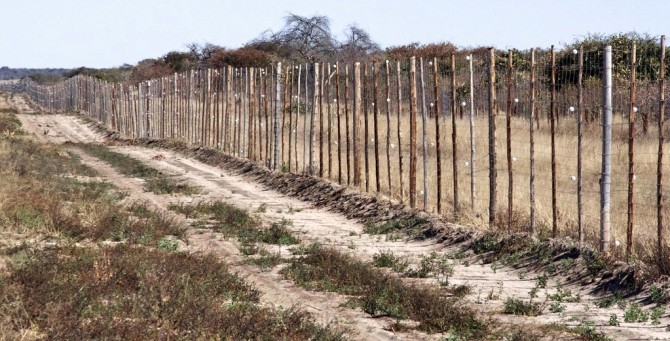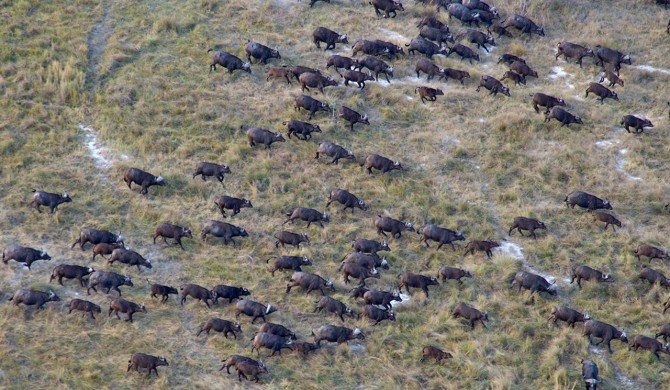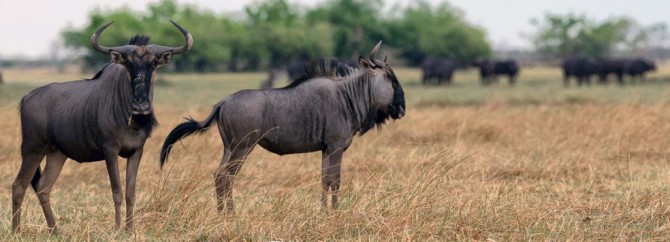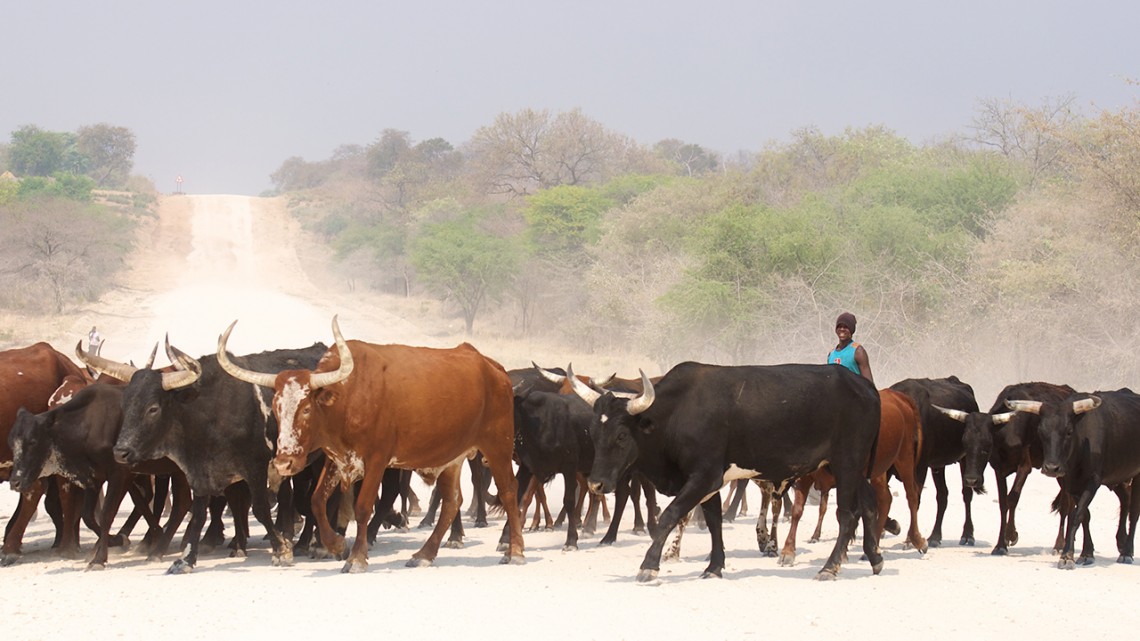
A beef cattle farmer manages his herd in the Zambezi region, Namibia.
Saving Africa’s wildlife: cattle, conservation and collaboration
By Jackie Swift
In the early 1990s, Steven Osofsky, D.V.M. ’89, was fresh out of Cornell’s College of Veterinary Medicine (CVM) and headed for southern Africa as Botswana’s first official wildlife veterinarian.
One of the first things he noticed when he got there were thousands of miles of fences. They separated domestic beef cattle from wild buffalo because buffalo carry the virus for foot-and-mouth disease (FMD), which can sicken cattle and lead to trade embargoes on beef from affected countries.
The fences also cut across the ancient migratory routes of the region’s historically vast ungulate herds, with devastating consequences.
“Hundreds of thousands, if not millions, of animals have died along these fences since the 1950s,” Osofsky says, “because they couldn’t get access to seasonal grazing and fresh water.”
There was intense conflict between the livestock and wildlife sectors, and he saw it firsthand.
“Botswana is one of the last great places on Earth for free-ranging wildlife,” says Osofsky, now the Jay Hyman Professor of Wildlife Health and Health Policy at CVM. “But fences are a barrier to the habitat connectivity these species evolved with over millennia, and they’ve significantly impacted the region’s wildlife. I’ve spent a lot of time since the 1990s thinking about this land-use conundrum, wherein two sectors have been seen as impacting each other in such dramatically negative ways.”
The One Health strategy
Osofsky’s concerns for both wildlife and human well-being drove him to help catalyze an approach called One Health.
“This is the overriding theme of most of my work,” says Osofsky, a member of the Cornell Global Grand Challenge’s Migrations initiative. “My focus is very much on wildlife conservation and the ways in which we can be better stewards of the environment and how that relates back to the health of wildlife, domestic animals and people.”
The approach led Osofsky to facilitate dialogue among southern African governments, international donors, the World Organization for Animal Health (OIE), the Food and Agriculture Organization of the United Nations, small farmers and farming communities, and others with a stake in the clash between the needs of wildlife and beef farmers in the region. Osofsky – a faculty associate at the Mario Einaudi Center for International Studies’ Institute for African Development – and his team worked with colleagues in the Southern African Development Community to identify the crux of the problem.
The OIE’s regulatory framework had long required any aspiring beef-exporting country or region to physically separate wildlife with FMD from livestock. This led governments in southern Africa to erect extensive fences.
But with today’s scientific understanding and sophisticated food safety protocols, Osofsky and his colleagues concluded that the OIE’s goals could be equally well-served by focusing on beef production.
“Whether you’re talking about E. coli or FMD or a parasite, how you deal with the product from a biosafety viewpoint is what you really need to worry about,” Osofsky says. “You can process meat, vegetables or any food by using standardized approaches based on good science – farm to fork, as they say – to make sure the end products are safe for human consumption, while at the same time ensuring that a product like beef doesn’t spread an animal disease.
“It took many years of dialogue,” he says, “before the OIE acknowledged that what is essentially a food safety approach is equivalent to the geographic, fence-based approach.”
In 2015 the OIE’s World Animal Health Assembly updated OIE guidelines so that fences were no longer the only option for managing FMD in southern Africa.
Planetary health
As Osofsky worked on the fence problem in southern Africa, as well as other environmental and wildlife conservation issues, he used health concerns to gain policy traction. Eventually, he brought together a diverse array of colleagues to help develop a new field, subsequently dubbed “planetary health” by The Rockefeller Foundation.
“Planetary health is about improving both our understanding of the public health impacts of anthropogenic environmental change and our ability to measure them,” he says, noting the approach can also improve decision-making in land-use planning, ocean-use planning, environmental conservation and public health policy.
“If governments want to dam the Amazon River’s tributaries for hydroelectric energy, for example, but project assessments neglect to look at the millions of people who depend on migratory fish in that freshwater basin for protein and micronutrient nutrition, then we could be missing one of the largest real costs resulting from the dams,” Osofsky says.
The Cornell Wildlife Health Center
In 2016, Osofsky came full circle and joined the faculty of CVM. One of his first steps was to help develop the Cornell Wildlife Health Center, formerly known as Wildlife Health Cornell.
“The array of exciting wildlife health work underway across the veterinary college, much of it involving other parts of the university as well as external partners, created a window of opportunity to build a real community of practice,” Osofsky says.
With part of a $1.7 million grant from The Rockefeller Foundation, Osofsky and his team have been evaluating the potential impact of combining traditional environmental impact assessment with the concept of health impact assessment. This work will help inform policymakers at a range of scales so that certain issues – such as how alterations to natural systems will impact public health and well-being – are taken into account proactively.
The other portion of the grant – and funding from the Academic Venture Fund at the Cornell Atkinson Center for Sustainability, where Osofsky is a faculty fellow – has been assisting local beef farmers living with wildlife in southern Africa. The goal is to help them sell their beef on the world market while supporting the environment needed for reevaluation of fences impacting key wildlife migration corridors.
Given those new land-use opportunities, in 2019 Botswana restarted the National Committee on Cordon Fences, a multi-agency effort that had been abandoned more than 20 years before. The rejuvenated committee advises on wildlife-friendly fencing options, alternatives to fences and management of transboundary wildlife, including the need for migratory corridors.
“This action is a huge milestone,” Osofsky says, “one that reinforces Botswana’s regional leadership in integrating conservation and development.”
A global treasure
Osofsky focuses on the Kavango Zambezi (KAZA) Transfrontier Conservation Area, a conservation and development initiative that spans five countries: Botswana, Namibia, Angola, Zambia and Zimbabwe. KAZA’s wilderness is home to more than half of all remaining African elephants, and many other endangered and threatened species.
The KAZA Secretariat asked Osofsky’s team to help bring the livestock and wildlife veterinarians of all five KAZA countries together to discuss the approach and other issues related to transboundary disease management and conservation. The KAZA Animal Health Working Group has convened several times, with Cornell’s technical assistance.
Osofsky is seeing evidence, on the ground and in the policy arena, that this new approach to livestock disease risk management is taking hold. In 2019, the Southern African Development Community’s Council of Ministers adopted his team’s guidelines on commodity-based trade approaches for managing FMD risk. The guidelines have the potential to address conflicts at the livestock/wildlife interface that have been unresolved for 70 years.
“There was an old fence line in Botswana that got opened up a few years ago,” Osofsky says. “There were no living zebras that had ever made their ancestral migration across the region. And yet, as soon as the fence was no longer a barrier, the migration was restored. The zebras followed the same route used by previous generations. That tells me it’s not too late.”
This article is adapted from the original, “Cattle, Conservation and Collaboration” by Jackie Swift, published by Cornell Research.
Media Contact
Get Cornell news delivered right to your inbox.
Subscribe